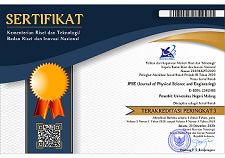Analysis of Nanoporous Semiconductor Film Thickness Effect on Short Circuit Current Density of β-Carotene Dye based DSSC: Theoretical and Experimental Approach
Abstract
Dye-sensitized solar cells (DSSC) made of TiO2 have received increasing attention since O’Regan and Gratzel published their work in Nature in 1991 [1]. Some studies have been conducted to determine the effect of the TiO2 electrode thickness on the DSSC performance. Nevertheless, the effect of the electrode thickness on the J–V characteristics, especially the short circuit current density (Jsc), has not been adequately addressed. Therefore, in this investigation, parametric analyses were conducted to study the DSSC electrode thickness effect on Jsc. Diffusion model was used to derive the equation of nanoporous semiconductor film thickness (d) dependence on Jsc. TiO2 paste was prepared using same method as Ref. [2]. The cells I-V curve were characterized using a computerized digital multi-meter (Keithley 2400) with a variable load. The cells short circuit current (Jsc) data gotten from the I-V characterization were plotted as the function of the thickness of TiO2 films. The result of the data plot was then compared and fitted with the theoretical modelling result. It is apparent that the DSSC performance largely depends on the TiO2 film thickness. The results was also showed that the diffusion model provided good approximation to describe the dependence of Jsc on the film thickness of DSSC.
Keywords
Full Text:
PDFReferences
B. O’Regan and M. Grätzel, “A Low-Cost, High-Efficiency Solar Cell Based on Dye-Sensitized Colloidal TiO2 Films,” Nature, vol. 353, no. 6346, pp. 737–740, 1991.
S. Mathew et al., “Dye-Sensitized Solar Cells with 13% Efficiency Achieved Through The Molecular Engineering of Porphyrin Sensitizers,” Nat. Chem., vol. 6, no. 3, pp. 242–247, 2014.
J. Gong et al., “Review on Dye-Sensitized Solar Cells (DSSCs): Advanced Techniques and Research Trends,” Renew. Sustain. Energy Rev., vol. 68, pp. 234–246, 2017.
B. A. Gregg, “Interfacial Processes in The Dye-Sensitized Solar Cell,” Coord. Chem. Rev., vol. 248, no. 13–14, pp. 1215–1224, 2004.
M. Grätzel, “Solar Energy Conversion by Dye-Sensitized Photovoltaic Cells,” Inorg. Chem., vol. 44, no. 20, pp. 6841–6851, 2005.
Y. Wang et al., “Density of State Determination of two Types of Intra-Gap Traps in Dye-Sensitized Solar Cells and Its Influence on Device Performance,” Phys Chem Chem Phys, vol. 16, no. 23, pp. 11626–11632, 2014.
P.-T. Hsiao, Y.-L. Tung, and H. Teng, “Electron Transport Patterns in TiO2 Nanocrystalline Films of Dye-Sensitized Solar Cells,” J. Phys. Chem. C, vol. 114, no. 14, pp. 6762–6769, 2010.
J. Villanueva-Cab et al., “Trap-Free Transport in Ordered and Disordered TiO2 Nanostructures,” Nano Lett., vol. 14, no. 5, pp. 2305–2309, 2014.
R. Yang et al., “Fabrication of TiO2 Hollow Microspheres Assembly from Nanosheets (TiO2-HMSs-NSs) with Enhanced Photoelectric Conversion Efficiency in DSSCs and Photocatalytic Activity,” Appl. Catal. B Environ., vol. 210, pp. 184–193, 2017.
S. A. Kazmi et al., “Electrical and Optical Properties of Graphene-TiO2 Nanocomposite and Its Applications in Dye Sensitized Solar Cells (DSSC),” J. Alloys Compd., vol. 691, pp. 659–665, 2017.
S. Kundu et al., “Enhancing the Efficiency of DSSCs by the Modification of TiO2 Photoanodes using N, F, and S, co-doped Graphene Quantum Dots,” Electrochimica Acta, vol. 242, pp. 337–343, 2017.
S. Soedergren et al., “Theoretical Models for The Action Spectrum and The Current-Voltage Characteristics of Microporous Semiconductor Films in Photoelectrochemical Cells,” J. Phys. Chem., vol. 98, no. 21, pp. 5552–5556, 1994.
R. Gomez and P. Salvador, “Photovoltage Dependence on Film Thickness and Type of Illumination in Nanoporous Thin Film Electrodes According to A Simple Diffusion Model,” Sol. Energy Mater. Sol. Cells, vol. 88, no. 4, pp. 377–388, 2005.
C.-H. Chao et al., “Rapid Thermal Melted TiO2 Nano-Particles into ZnO Nano-Rod and Its Application for Dye Sensitized Solar Cells,” Thin Solid Films, vol. 518, no. 24, pp. 7209–7212, 2010.
P. Gu et al., “Influence of Electrolyte Proportion on The Performance of Dye-Sensitized Solar Cells,” AIP Adv., vol. 7, no. 10, p. 105219, 2017.
Y. Guo et al., “Preparation of Titanate Nanotube Thin Film Using Hydrothermal Method,” Thin Solid Films, vol. 516, no. 23, pp. 8363–8371, 2008.
M. C. Kao et al., “The Effects of The Thickness of TiO2 Films on The Performance of Dye-Sensitized Solar Cells,” Thin Solid Films, vol. 517, no. 17, pp. 5096–5099, 2009.
M. Ni, M. K. H. Leung, and D. Y. C. Leung, “Theoretical Modelling of The Electrode Thickness Effect on Maximum Power Point of Dye-Sensitized Solar Cell,” Can. J. Chem. Eng., vol. 86, no. 1, pp. 35–42, 2008.
Y. Fukai et al., “Highly Efficient Dye-Sensitized SnO2 Solar Cells Having Sufficient Electron Diffusion Length,” Electrochem. Commun., vol. 9, no. 7, pp. 1439–1443, 2007.
I. Shin et al., “Analysis of TiO2 Thickness Effect on Characteristic of A Dye-Sensitized Solar Cell by Using Electrochemical Impedance Spectroscopy,” Curr. Appl. Phys., vol. 10, no. 3, pp. S422–S424, 2010.
M. Hamadanian et al., “The Effect of The Thickness of Nanoporous TiO2 Film on The Performance of Nanocrystalline Dye-Sensitized Solar Cell,” in 5th Symposium on Advances in Science and Technology, 2011.
K. Zouhri et al., “Numerical Method of The TiO2 Porosity Effect on Dye Sensitized Solar Cell Energy Efficiency,” Sol. Energy, vol. 155, pp. 920–933, 2017.
J.-J. Lee, G. M. Coia, and N. S. Lewis, “Current Density Versus Potential Characteristics of Dye-Sensitized Nanostructured Semiconductor Photoelectrodes,” J. Phys. Chem. B, vol. 108, no. 17, pp. 5269–5281, 2004.
Copyright (c) 2020 Solehudin Solehudin, Markus Diantoro, Arif Hidayat

This work is licensed under a Creative Commons Attribution-NonCommercial-ShareAlike 4.0 International License.
This work is licensed under a Creative Commons Attribution-ShareAlike 4.0 International License



















